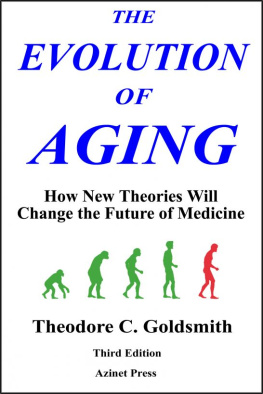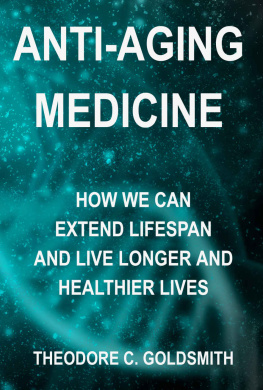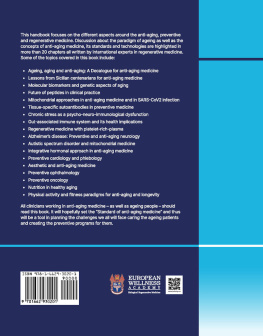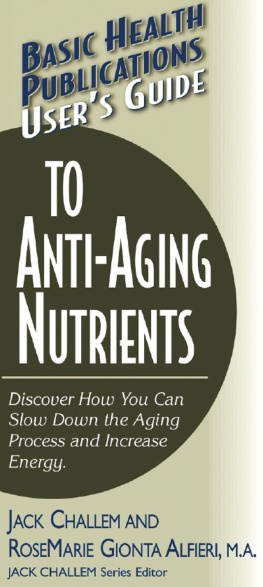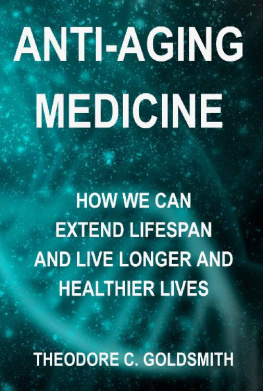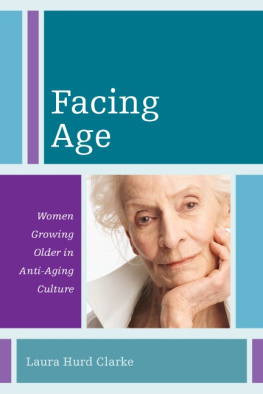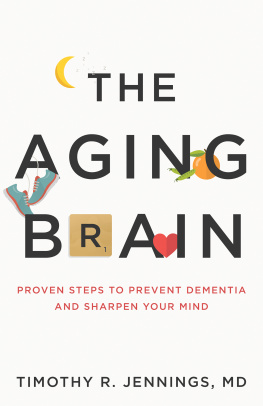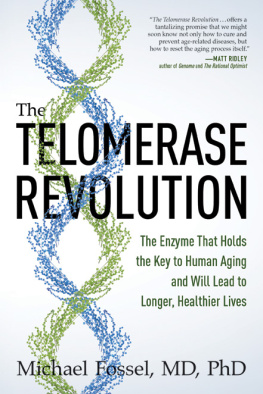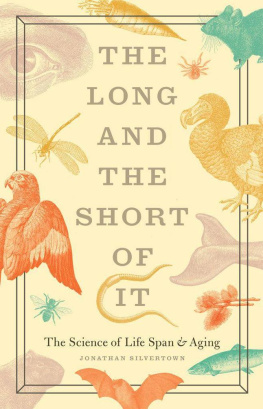The Evolution of Aging
How New Theories Will Change the Future ofMedicine
Third Edition
Theodore C. Goldsmith
Copyright 2013 Azinet Press
Azinet Press
Box 239 Crownsville, MD 21032
Smashwords Edition
ISBN: 9781301444366
This document inPDF format: http://www.azinet.com/aging/Aging_Book.pdf
Print Versions:
The Evolution of Aging Second Edition, TheodoreC. Goldsmith
ISBN: 0-9788709-0-5 10/2006
Available: Amazon.com, Barnes and Noble, etc.,trade paperback.
First edition: ISBN: 0-595-28069-2 6/20/2003trade paperback
Cover art: Bulent Ince.
Keywords: ageing, antiaging, senescence,regenerative medicine, gerontology, evolution, health, biology,anti-aging medicine, science
April 20, 2013
Summary:
Why do we age? Thisquestion has baffled scientists for 150 years and remainsunresolved. Scientists disagree over even the general nature ofaging. Is aging the result of fundamental limitations that apply toall living things, do we age because our bodies do not try hardernot to age, or are organisms designed by nature or programmed toage because a limited life span conveys some evolutionaryadvantage? All of the scientific theories either fail to fullyexplain observed animal characteristics or conflict with widelyaccepted evolutionary mechanics theory.
This issue has potentially enormousimplications for medicine. If aging is the result of fundamentaland unalterable forces of nature, then anti-aging medicine isimpossible and anti-aging research is futile and foolish. If agingis dictated by a species-specific design, then research may wellreveal means for altering the operation of the aging mechanism andthereby improve the treatment of many age-related diseases andconditions.
This book provides a review of theories ofbiological aging including underlying evolution and genetics issuesand describes recent discoveries and theories that overwhelminglyfavor programmed aging and therefore suggest that increasedresearch on aging mechanisms would be highly beneficial to publichealth.
Keywords : Aging Theories, Evolution,Longevity, Gerontology, Anti-aging, Darwin, Evolutionary Theoriesof Aging, Life Extension, Geriatric Medicine, Ageing, biologicalclock, science, biology
Copyright 2003 - 2012 Theodore C. Goldsmith(tgoldsmith@azinet.com). All rights reserved.
Acknowledgements
The author wishes to thank the many peoplewho helped with this book or provided helpful comments andsuggestions regarding the underlying material including JoshuaMitteldorf (University of Arizona), Vladimir Skulachev (MoscowState University), Jeff Bowles, Aubrey de Grey (University ofCambridge), Vicky Cahan (National Institute on Aging), and JoaoMagalhaes (Harvard Medical School).
Thanks also to Frann Goldsmith for herediting assistance and Elaine Bailey (Trident Press International)for editorial comments.
Photo and Illustration Credits
Photos of Darwin, August Weismann, PeterMedawar, and Galapagos tortoise from Wikipedia.
Russian LanguageVersion
The Commission for Publication of BiologicalMonographs (MAIK Nauka-Interperiodika Publishers - Russian Academyof Sciences) has selected an earlier version of this document forpublication in Russian. Although translation has been completed,actual publication was cancelled because of budgetary constraints.We are attempting to obtain permission for Internet distribution ofthe Russian document:
Science Abstract:
In 1882 Weismann formally proposed thatprogrammed aging was an evolved characteristic, an adaptation oforganism design, which had an evolutionary purpose. Darwin hadpreviously suggested that aging was an evolved characteristicdespite conflicts with Darwinian evolutionary mechanics.
Many current theorists have discardedadaptive theories of aging using one or more of the followingarguments: Some theorists consider it impossible that aging couldbe an adaptation because adaptive theory conflicts with theirtheory of natural selection. Others rejected adaptive theoriesbecause no propagation mechanism had been demonstrated that wouldprovide for the evolution of a fitness-adverse trait such as aging.Finally, some doubt that aging has evolutionary utility.
This book, written for a wide audience,presents arguments that refute all of these objections, concludesthat programmed aging is the correct theory beyond a reasonabledoubt, and provides a summary of modern programmed aging theoriesas well as an analysis of the potential public health implicationsof adaptive theories.
Preface
I am often asked: Why is digitalcommunications theory important to genetics, evolution, andtheories of biological aging? Biology and space communicationscertainly seem to be entirely unrelated.
However, there is actually an important andvery interesting connection. All living organisms have the abilityto communicate their design characteristics to their descendants bymeans of their genetic codes. This inter-generational geneticdigital communications system is strikingly similar to modern spacecommunications systems. The genetic code is a serial digital datastream. Nature and NASA face similar issues in areas such as dataredundancy, error recovery, synchronization, and data merging, andhave developed similar solutions. Both systems have benefits andlimitations conferred by the fundamental nature of digitalcommunications.
Evolution is the process whereby geneticcodes are modified, initially as the result of transmissionerror. Evolution is therefore highly dependent on the details ofthe genetic communications and data storage scheme including thedigital benefits and limitations.
Finally, as the title of this book implies,theories of aging and anti-aging research are very constrained byevolution theory.
The merging of biology and informationtechnology has spawned a number of new fields of science includinggenomics, and proteomics, under the general termbioinformatics. My main area of scientific interest concernsthe consequences of the digital nature of the geneticcommunications system on evolution theory and thereby agingtheory.
Some say: Darwin was wrong. Others takethe position that Darwin was 100 percent correct and that any validdeviation is impossible. This book presents the case that Darwinwas perhaps 99 percent correct. Digital genetics analysis and otherevidence suggest that minor adjustments to Darwins theory arenecessary. Although these changes have little effect on our generalunderstanding of evolution, they have a crucial effect on agingtheory.
In order to facilitate worldwide access tothis material, especially for students, this book is being madeavailable for free download on the Internet. Distribution via theInternet also allows for frequent additions, revisions, andupdates. Communications from readers have been very helpful inmaking these revisions so please continue sending your comments andcriticisms.
Because of these revisions, the initialpaperback version of this document, ISBN 0595280692, published inJune 2003, is now seriously out of date. A second edition, ISBN0978870905 was published in October 2006.
Theodore. C. Goldsmith
Annapolis, Maryland
Contents
1. Introduction
Why Do WeAge?
The importance of this question isdetermined by your preconception of the answer.
If you think aging is an inescapablebiological reality, an inevitable fact of life, or otherwise causedby a process that is so fundamental, so immutable, and so centralto the process of life that no alteration is possible, thendetermining the cause is academic and of little importance. If youthink this, there is nothing that can be done about the root causeof aging. Spending much effort or money on finding the cause isfoolish. Gerontology research should be confined to theamelioration of symptoms and treatment of specific age-relatedconditions such as Alzheimers disease, heart disease, andcancer.

